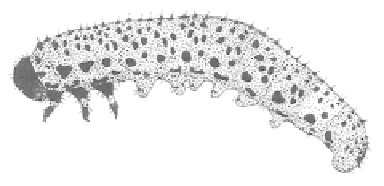Agriculture Reference
In-Depth Information
Fig.
336 Larva of common gooseberry sawfly.
Nematus ribesii
(x4).
Fig.
337 Larva of pale-spotted gooseberry sawfly.
Nematus leucotrochus
(x4).
several instars and become fully grown in about 3
weeks. Individuals then moult into active
prepupae (these are sometimes thought to be
larvae of a different species of sawfly; see de-
scription below). The prepupae soon disperse
and enter the soil to spin oval, dark brown,
parchment-like cocoons 10-15 cm below the sur-
face. Individuals then pupate, and adults of the
next generation appear shortly afterwards.
There are usually up to three generations annu-
ally, and larvae occur throughout the summer
into early autumn.
only small numbers, are distinguished from those
of
N. ribesii
by their green, black-spotted head
and their smaller pinacula
(Fig. 337).
Nematus olfaciens
Benson
Black currant sawfly
This pest occurs on various kinds of
Ribes
but is
associated mainly with black currant. The larvae
sometimes cause extensive defoliation. In com-
mercial black currant plantations, the larvae may
also contaminate trays of mechanically harvested
fruit. There are two or three generations annu-
ally. The green-headed larvae (cf.
Nematus
ribesii.
p. 251) are similar in appearance to those
of
N. leucotrochus
(above) but the pinacula are
noticeably larger and often coalesce.
DESCRIPTION
Adult female
6-7 mm long, mainly yellow with a
black-marked thorax;
head
black;
antennae
dark
above and pale below.
Adult male
5-6 mm
long, dark-bodied;
antennae
entirely dark.
Egg
1.2mm long, pale greenish-white.
Larva
up to
20 mm long;
body
mainly green, with the first,
part of the second and last two body segments
orange;
pinacula
large, black and shiny, each
bearing one or more black setae;
head
black and
shiny;
thoracic legs
black;
abdominal prolegs
seven pairs present
(Fig. 336)
(cf. magpie moth,
Abraxas grossulariata,
p. 228).
Prepupa
mainly
pale bluish-green, with the first and last two body
segments pale orange;
pinacula
inconspicuous.
Pachynematus clitellatus
(Lepeletier)
This sawfly is associated with various members
of the Poaceae, including cultivated wheat. The
larvae feed on the leaves; they cause noticeable,
but only minor, damage.
BIOLOGY
Adults of this univoltine species occur from May
onwards, and eggs are deposited in the edges of
expanded leaves. Larvae occur mainly in June
and July. Fully grown individuals enter the soil
where they eventually pupate, each in a thin co-
coon (cf.
Dolerus
spp., p. 249
etseq.).
Nematus leucotrochus
Hartig
Pale-spotted gooseberry sawfly
This species is associated with gooseberry and,
occasionally, red currant and white currant. Un-
like
Nematus ribesii
(p. 251), it is univoltine;
adults occur in May and the larvae feed mainly in
May and June. The larvae, which usually occur in
DESCRIPTON
Adult
6-7 mm long, black, marked extensively
with pale yellow;
male
with head and thorax


